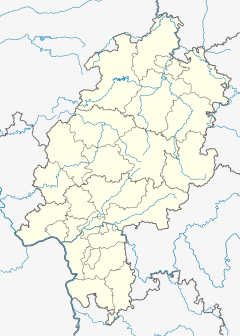
Frankfurt (Main) Hauptbahnhof, also called Frankfurt Central Station and Frankfurt Main Station, is the busiest train station in the German state of Hesse. Due to its location near the middle of Germany and usage as a transport hub for long and short distance travelling, Deutsche Bahn refers to it as the most important station in Germany.

Köln Hauptbahnhof is the central railway station of Cologne, Germany. The station is an important local, national and international transport hub, with many ICE, Eurostar and Intercity trains calling there, as well as regional Regional-Express, RegionalBahn and local S-Bahn trains. EuroNight and Nightjet night services also call at the station. It has frequent connections to Frankfurt by way of the Cologne–Frankfurt high-speed rail line, which starts in southern Cologne. On an average day, about 280,000 travellers frequent the station, making it the fifth busiest station in Germany.
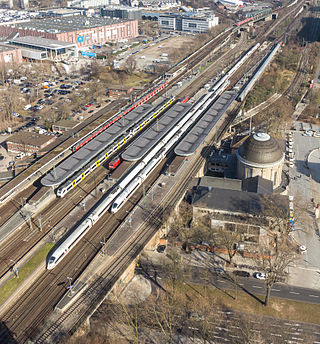
Köln Messe/Deutz station is an important railway junction for long-distance rail and local services in the Deutz neighborhood of Cologne in the German state of North Rhine-Westphalia. It is situated close to the eastern bank of the Rhine and connected via the Hohenzollern Bridge to Köln Hauptbahnhof, the city's main station, which is just a few hundred metres away. The Cologne Trade Fair grounds are directly north of the station, hence the Messe in the station's name. The Deutz/Messe station of the Cologne Stadtbahn is nearby and connected to this station by a pedestrian tunnel.

Bonn Hauptbahnhof is a railway station located on the left bank of the Rhine along the Cologne–Mainz line. It is the principal station serving the city of Bonn. In addition to extensive rail service from Deutsche Bahn it acts as a hub for local bus, tram, and Stadtbahn services.

Mannheim Hauptbahnhof is a railway station in Mannheim in the German state of Baden-Württemberg. It is the second largest traffic hub in southwestern Germany behind Stuttgart Hauptbahnhof, with 658 trains a day, including 238 long-distance trains. It is also a key station in the Rhine-Neckar S-Bahn. 100,000 passengers embark, disembark or transfer between trains at the station each day. The station was modernised in 2001. It is classified by Deutsche Bahn as a category 2 station.

Mannheim–Frankfurt railway is a German standard gauge, electrified railway line and runs in southern Hesse and northern Baden-Württemberg between Frankfurt and Mannheim. It is also called the Riedbahn. The line runs through an area called the Hessische Ried, hence the name. The term Riedbahn was originally used for the Darmstadt–Worms railway and the two lines share the central section between Groß-Gerau and Biblis.
The Rhine-Neckar S-Bahn(S-Bahn RheinNeckar) forms the backbone of the urban rail transport network of the Rhine Neckar Area, including the cities of Mannheim, Heidelberg and Ludwigshafen.
The Main Railway is a 37.5 km-long double-track electrified railway line, which runs on the south side of the river Main from Mainz to Frankfurt central station.

The Frankfurt–Mannheim high-speed railway is a planned German high-speed railway between Frankfurt am Main and Mannheim.

The Mannheim–Saarbrücken railway is a railway in the German states of Baden-Württemberg, Rhineland-Palatinate and the Saarland that runs through Ludwigshafen am Rhein, Neustadt an der Weinstraße, Kaiserslautern, Homburg and St. Ingbert It is the most important railway line that runs through the Palatinate. It serves both passenger and freight transport and carries international traffic.
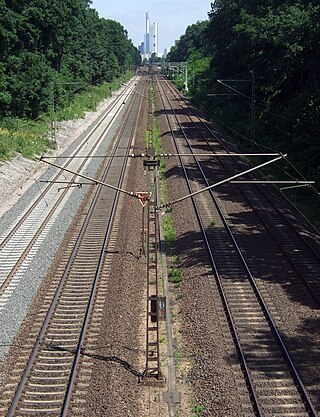
The Main-Neckar Railway is a main line railway west of the Odenwald in the Upper Rhine Plain of Germany that connects Frankfurt am Main to Heidelberg via Darmstadt, Bensheim and Weinheim. It was opened in 1846 and is one of the oldest railways in Germany.
The Frankfurt Airport loop is a 15.8-kilometre-long (9.8-mile) double-track railway line connecting Frankfurt and Frankfurt Airport and operated as part of the Frankfurt S-Bahn. It is electrified at 15 kV/16.7 Hz.

Hanau Hauptbahnhof is a railway station in Hanau in the German state of Hesse, and is a major railway junction east of Frankfurt am Main. It was opened in 1867, but the current building was built in the late 1960s. It is located about 1.5 kilometres (0.93 mi) south-east of central Hanau. It is classified by Deutsche Bahn (DB) as a category 2 station and has many train services, including Intercity Express, regional and S-Bahn services.
Homburg (Saar) Hauptbahnhof is a railway station in the town of Homburg in the German state of Saarland. It is a through station with four platforms and seven platform tracks and is classified by Deutsche Bahn as a station of category 3. It is located at the junction of the Homburg–Neunkirchen line and the Mannheim–Saarbrücken line. It has been the western terminus of line S1 of the Rhine-Neckar S-Bahn since 2006.
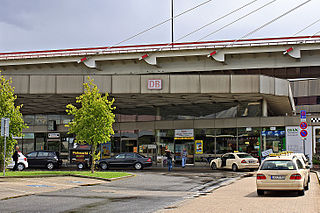
Ludwigshafen (Rhein) Hauptbahnhof is a railway station at Ludwigshafen am Rhein in the German state of Rhineland-Palatinate. A combination of a wedge-shaped station and a two-level interchange, the station is at the junction on the lines from Mainz and Neustadt an der Weinstrasse to Mannheim. It is classified by Deutsche Bahn as a category 2 station. The Ludwigshafen station was built in 1847 as a terminal station in the centre of modern Ludwigshafen. The current station was built in 1969 to the west of the city centre, but has not proved to be a success due to its poor location

Frankfurt-Niederrad station is a station in the district of Niederrad in the southwest of Frankfurt am Main in the German state of Hesse.

Biblis station is the only station of the town of Biblis in the German state of Hesse. It is classified by Deutsche Bahn as a category 4 station. The station is located on the Mannheim–Frankfurt railway, where the Worms–Biblis railway branches off to Worms. Both lines developed from the Riedbahn.

Weinheim (Bergstraße) Hauptbahnhof is a station in the town of Weinheim in the German state of Baden-Württemberg. It is served by Intercity services on the Main-Neckar Railway between Frankfurt and Heidelberg/Mannheim. The Weschnitz Valley Railway (Weschnitztalbahn) to Furth in the Odenwald starts at Weinheim station. There is also a freight railway to Viernheim, the last remaining section of the former Weinheim–Worms railway.
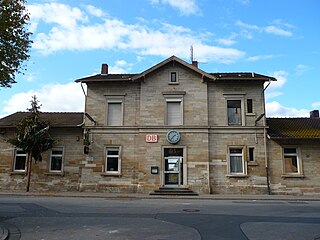
Riedstadt-Goddelau station, along with Riedstadt Wolfskehlen station, serves the town of Riedstadt in the south of the German state of Hesse on the Mannheim–Frankfurt railway and the Darmstadt–Worms railway. The station is classified by Deutsche Bahn as a category 4 station. It is served by local and S-Bahn trains.

The Western Entrance to the Riedbahn is a 9.5 km-long line in the German state of Baden-Württemberg, opened in 1985. It gives direct access from the Mannheim–Frankfurt railway from the north to the western end of Mannheim central station, allowing trains to the east and the south to continue without reversal.



